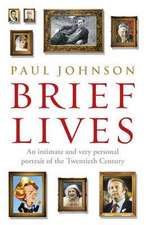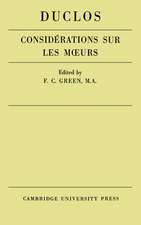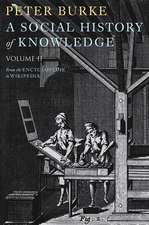The Preservation of Open Spaces, and of Footpaths, and Other Rights of Way: A Practical Treatise on the Law of the Subject: Cambridge Library Collection - British and Irish History, 19th Century
Autor Robert Hunteren Limba Engleză Paperback – 2 oct 2011
Din seria Cambridge Library Collection - British and Irish History, 19th Century
-
 Preț: 275.77 lei
Preț: 275.77 lei -
 Preț: 357.62 lei
Preț: 357.62 lei - 19%
 Preț: 725.60 lei
Preț: 725.60 lei -
 Preț: 355.86 lei
Preț: 355.86 lei - 23%
 Preț: 1279.99 lei
Preț: 1279.99 lei -
 Preț: 313.87 lei
Preț: 313.87 lei - 23%
 Preț: 1081.79 lei
Preț: 1081.79 lei - 23%
 Preț: 2443.23 lei
Preț: 2443.23 lei -
 Preț: 202.90 lei
Preț: 202.90 lei -
 Preț: 276.01 lei
Preț: 276.01 lei -
 Preț: 275.77 lei
Preț: 275.77 lei -
 Preț: 407.56 lei
Preț: 407.56 lei -
 Preț: 331.14 lei
Preț: 331.14 lei -
 Preț: 248.84 lei
Preț: 248.84 lei -
 Preț: 330.16 lei
Preț: 330.16 lei -
 Preț: 519.83 lei
Preț: 519.83 lei -
 Preț: 421.20 lei
Preț: 421.20 lei -
 Preț: 370.01 lei
Preț: 370.01 lei -
 Preț: 278.22 lei
Preț: 278.22 lei - 19%
 Preț: 477.33 lei
Preț: 477.33 lei -
 Preț: 422.16 lei
Preț: 422.16 lei -
 Preț: 278.99 lei
Preț: 278.99 lei -
 Preț: 248.28 lei
Preț: 248.28 lei -
 Preț: 277.07 lei
Preț: 277.07 lei -
 Preț: 287.73 lei
Preț: 287.73 lei -
 Preț: 338.14 lei
Preț: 338.14 lei - 19%
 Preț: 596.21 lei
Preț: 596.21 lei -
 Preț: 375.10 lei
Preț: 375.10 lei -
 Preț: 353.31 lei
Preț: 353.31 lei -
 Preț: 366.74 lei
Preț: 366.74 lei -
 Preț: 368.10 lei
Preț: 368.10 lei -
 Preț: 252.15 lei
Preț: 252.15 lei -
 Preț: 442.83 lei
Preț: 442.83 lei -
 Preț: 330.93 lei
Preț: 330.93 lei -
 Preț: 280.17 lei
Preț: 280.17 lei -
 Preț: 222.36 lei
Preț: 222.36 lei -
 Preț: 368.69 lei
Preț: 368.69 lei -
 Preț: 278.61 lei
Preț: 278.61 lei -
 Preț: 371.20 lei
Preț: 371.20 lei -
 Preț: 522.33 lei
Preț: 522.33 lei -
 Preț: 369.62 lei
Preț: 369.62 lei -
 Preț: 519.66 lei
Preț: 519.66 lei - 19%
 Preț: 533.47 lei
Preț: 533.47 lei -
 Preț: 465.38 lei
Preț: 465.38 lei -
 Preț: 467.33 lei
Preț: 467.33 lei -
 Preț: 240.12 lei
Preț: 240.12 lei
Preț: 422.01 lei
Nou
Puncte Express: 633
Preț estimativ în valută:
80.76€ • 83.43$ • 67.21£
80.76€ • 83.43$ • 67.21£
Carte tipărită la comandă
Livrare economică 26 martie-09 aprilie
Preluare comenzi: 021 569.72.76
Specificații
ISBN-13: 9781108036740
ISBN-10: 1108036740
Pagini: 454
Dimensiuni: 140 x 216 x 26 mm
Greutate: 0.57 kg
Editura: Cambridge University Press
Colecția Cambridge University Press
Seria Cambridge Library Collection - British and Irish History, 19th Century
Locul publicării:Cambridge, United Kingdom
ISBN-10: 1108036740
Pagini: 454
Dimensiuni: 140 x 216 x 26 mm
Greutate: 0.57 kg
Editura: Cambridge University Press
Colecția Cambridge University Press
Seria Cambridge Library Collection - British and Irish History, 19th Century
Locul publicării:Cambridge, United Kingdom
Cuprins
Preface; List of cases; List of statutes; Table of abbreviations; Part I. Of Commons and Other Open Spaces: 1. Of the nature of a common and the rights thereon; 2. Of the inclosure of a manorial common by the Lord of the Manor; 3. Of rights of common connected with the manorial system; 4. Of rights of common not connected with the manorial system; 5. Of common of estovers and common of turbary; 6. Of rights of digging gravel and other species of sub-soil; 7. Of rights of sole vesture and sole pasture; 8. Of claims by the inhabitants of a district to enjoy rights on a common; 9. Of the mode of ascertaining common rights, and of the loss or extinguishment thereof; 10. Of the power of local authorities to prevent inclosures by the Lord of the Manor; 11. Of the inclosure of a manorial common by way of copyhold grant; 12. Of the disfigurement of a manorial common; and herein, of the powers of highway authorities; 13. Of the inclosure of a manorial common by the authority of parliament; 14. Of common fields, meadows, and pastures; 15. Of the waste and commonable lands of a forest; 16. Of village greens; 17. Of fuel allotments and recreation grounds; 18. Of exceptional provisions as to inclosure; 19. Of the appropriation of common lands for the purposes of industrial undertakings; 20. Of the regulation of commons as open spaces. I. Under the Metropolitan Commons Act; 21. Of the regulation of commons as open spaces. II. Under the Commons Act, 1876; Part II. Of Footpaths and Other Rights of Way: 1. Of the nature of a footpath; 2. Of the obstruction of footpaths; and, herein, of their dedication; 3. Of the remedies for the obstruction of footpaths; 4. Of the stoppage or diversion of a footpath by an order of Quarter Sessions; 5. Of the repair of footpath; 6. Of highways of an exceptional kind; 7. Of roadside waste; 8. Of fore-shore and cliffs; 9. Of rivers and lake; Appendices; Index.
Descriere
First published in 1896, this work is an expert account of the nineteenth-century state of the laws relevant to preservation.













